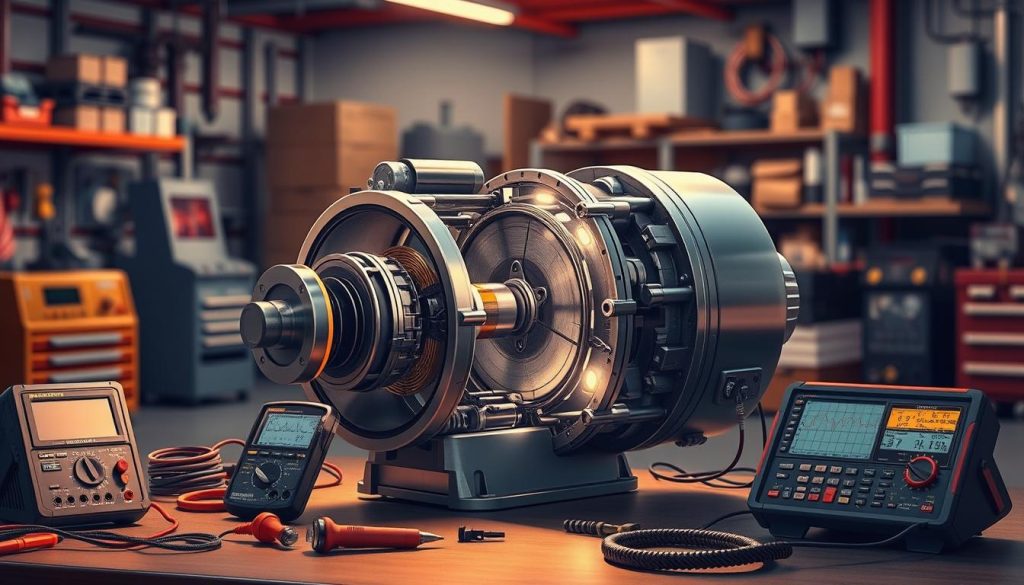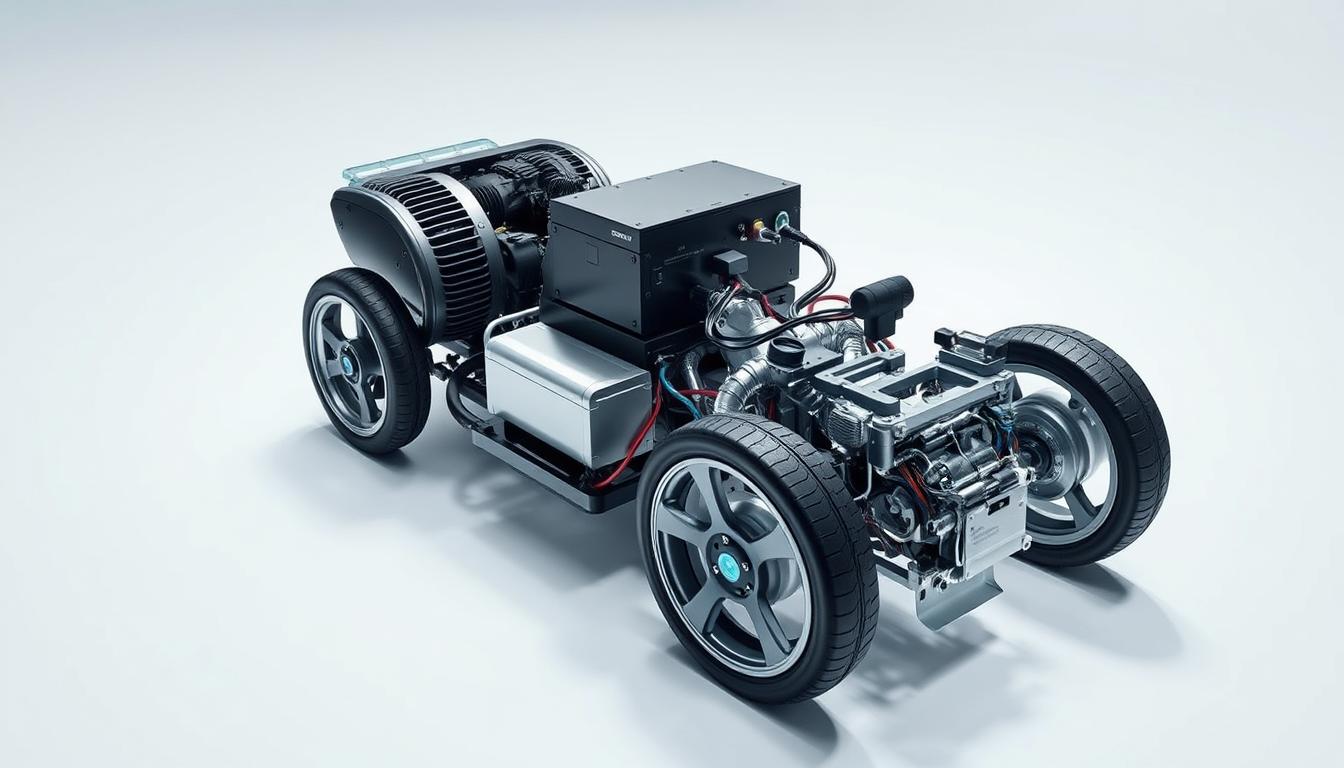Are you ready to shift your perspective on sustainable transportation? As the world moves towards a more environmentally friendly future, the question on everyone’s mind is: what’s next for ev technology?
The latest advancements in electric drivetrain are revolutionizing the way we think about transportation. With improved efficiency and performance, the electric vehicle drive system is becoming increasingly popular.
As we explore the latest developments in this field, it’s clear that the future of transportation is electric. But what does this mean for consumers and manufacturers alike?
Key Takeaways
Table of Contents
- Latest advancements in ev technology are improving efficiency and performance.
- The electric drivetrain is becoming increasingly popular.
- The future of transportation is shifting towards electric.
- Consumers and manufacturers are adapting to the changes.
- New developments are expected to drive growth in the industry.
The Fundamentals of Electric Vehicle Drive Systems
As the world shifts towards sustainable transportation technology, understanding the fundamentals of electric vehicle drive systems becomes increasingly important. These systems are the backbone of electric vehicles (EVs), enabling them to deliver exceptional performance while minimizing environmental impact.
Core Components That Power Modern EVs
The efficiency and performance of an EV are largely determined by its drive system, which consists of several key components.
Electric Motors: The Heart of the System
Electric motors convert electrical energy into mechanical energy, propelling the vehicle forward. They are designed to be highly efficient, providing instant torque and a smoother driving experience.
Inverters and Power Electronics
Inverters play a crucial role in managing the flow of electrical energy between the battery and the electric motor. They convert DC power from the battery to AC power for the motor, ensuring optimal performance.
How EV Drivetrains Differ from Traditional Vehicles
Unlike traditional internal combustion engine vehicles, EVs have simpler drivetrains with fewer moving parts. This simplicity results in lower maintenance costs and improved reliability.
| Component | EV Drivetrain | Traditional Drivetrain |
|---|---|---|
| Primary Power Source | Electric Motor | Internal Combustion Engine |
| Energy Storage | Battery Pack | Fuel Tank |
| Transmission | Single-Speed or Multi-Speed | Multi-Speed |
According to Elon Musk, “The electric motor is a very simple device, but it’s very powerful.” This simplicity and power are what make EVs an attractive option for those looking towards sustainable transportation technology.
How to Evaluate Electric Vehicle Drive System Performance
Understanding the performance of electric vehicle (EV) drive systems is crucial for potential buyers and enthusiasts alike. Evaluating an EV’s drive system involves assessing several key performance metrics that directly impact the driving experience.
Key Performance Metrics to Consider
When evaluating an EV’s drive system, several metrics stand out. These include power and torque specifications, as well as efficiency ratings.
Power and Torque Specifications
Power output and torque are fundamental to an EV’s acceleration and overall performance. Higher torque values typically result in quicker acceleration.
Efficiency Ratings and What They Mean
Efficiency ratings indicate how effectively an EV converts electrical energy into motion. Higher efficiency means less energy is wasted, leading to better range and lower operating costs.
Translating Technical Specs to Real-World Experience
Technical specifications are just one aspect; real-world performance is equally important. Factors like driving habits, terrain, and weather conditions can significantly impact an EV’s actual performance.
| Metric | Description | Impact on Performance |
|---|---|---|
| Power Output | Measure of the EV’s ability to generate power | Directly affects acceleration |
| Torque | Rotational force that drives the wheels | Influences acceleration and towing capacity |
| Efficiency Rating | Percentage of electrical energy converted to motion | Affects range and operating costs |
Exploring Different Types of EV Motors and Their Applications
As the demand for electric vehicles continues to grow, understanding the different types of EV motors becomes increasingly important. The electric vehicle (EV) industry is witnessing significant advancements in motor technology, each with its unique benefits and applications.
Permanent Magnet Motors: Efficiency Champions
Permanent magnet motors are widely used in EVs due to their high efficiency and power density. They utilize rare-earth magnets to create the magnetic field, which enhances their performance. These motors are known for their ability to provide smooth and quiet operation, making them ideal for passenger vehicles.
Induction Motors: Tesla’s Original Choice
Induction motors, also known as asynchronous motors, were famously used by Tesla in their early models. They are known for their robustness and simplicity. These motors work by inducing a current in the rotor, which then generates torque. They are particularly effective in high-performance applications.
Axial Flux Motors: The Emerging Technology
Axial flux motors represent a newer technology that is gaining traction in the EV industry. They offer higher power-to-weight ratios compared to traditional motor designs. This makes them particularly appealing for applications where space and weight are critical factors.
Benefits for Performance and Range
- Improved efficiency
- Enhanced power density
- Better thermal management
Current Vehicle Models Using This Technology
Several EV models are now incorporating axial flux motors, including some of the latest offerings from major manufacturers. For instance,
some models are leveraging this technology to achieve better range and performance.
The diversity in EV motor technology is driving innovation in the electric vehicle industry. As manufacturers continue to explore different motor types, we can expect to see further improvements in EV performance and efficiency.
How Battery Technology Integrates with Drive Systems
The integration of battery technology with electric vehicle (EV) drive systems is crucial for optimizing performance and efficiency. Effective battery-to-motor power management is at the heart of this integration, ensuring that the electric car motor system operates smoothly.
Battery-to-Motor Power Management
Battery-to-motor power management involves the efficient transfer of energy from the battery to the electric drive components. This process is critical for maximizing the range and performance of EVs.
Voltage Considerations and Performance
Voltage considerations play a significant role in determining the performance of EV drive systems. Higher voltage systems can offer improved efficiency and faster charging times, contributing to sustainable transportation technology.
Thermal Management Challenges
Thermal management is another critical aspect of battery-to-motor power management. Effective cooling systems are necessary to prevent overheating, which can impact the performance and longevity of the battery and electric drive components.
Regenerative Braking: Extending Range Through Drive System Design
Regenerative braking is a key feature of EV drive systems, capturing kinetic energy and converting it back into electrical energy to recharge the battery. This process not only extends the range of EVs but also enhances overall efficiency.

Step-by-Step Guide to Optimizing Your Electric Vehicle Drive System
As an EV owner, optimizing your vehicle’s drive system can lead to improved range and overall performance. Optimizing your electric vehicle drive system involves a combination of software updates, driving techniques, and monitoring system health.
Software Updates and Their Impact on Drive Performance
Regular software updates can significantly enhance your EV’s drive system performance. These updates often include improvements to battery management, motor efficiency, and regenerative braking. For instance, Tesla frequently releases software updates that can improve the range and performance of their vehicles.
“Software updates are a critical component of maintaining and improving the performance of our electric vehicles,” said Elon Musk, CEO of Tesla. “By continuously updating our software, we can ensure that our vehicles are running at optimal levels.”
Driving Techniques to Maximize Efficiency
Driving techniques play a crucial role in maximizing the efficiency of your EV’s drive system. By adopting certain habits, you can significantly improve your vehicle’s range and performance.
Acceleration and Regenerative Braking Strategies
Smooth acceleration and effective use of regenerative braking can help maximize your EV’s efficiency. Sudden acceleration can drain the battery quickly, while regenerative braking can help recharge the battery.
Temperature Considerations for Optimal Performance
Temperature can significantly impact your EV’s drive system performance. Extreme temperatures can affect battery health and overall efficiency. It’s essential to park your vehicle in a shaded area or use a garage to maintain a stable temperature.
| Driving Technique | Impact on Efficiency |
|---|---|
| Smooth Acceleration | Improves range by up to 10% |
| Regenerative Braking | Recharges battery by up to 20% |
| Maintaining Optimal Temperature | Improves battery health and efficiency |
Monitoring System Health and Performance Metrics
Regularly monitoring your EV’s drive system health and performance metrics is crucial for identifying areas of improvement. Most EVs come equipped with onboard systems that provide insights into battery health, motor performance, and energy consumption.
Troubleshooting Common Electric Vehicle Drive System Issues
Understanding how to diagnose and fix common problems with EV drive systems can significantly enhance the driving experience. Electric vehicle owners may encounter various issues that affect the performance and efficiency of their vehicle’s drive system.
Diagnosing Drive System Performance Problems
Identifying the root cause of drive system issues is crucial. Common problems include reduced power output, unusual noises, and decreased efficiency.
Warning Signs of Motor Issues
Motor issues can manifest as unusual vibrations, overheating, or abnormal noises. Regular monitoring can help detect these problems early.
Power Electronics Failures
Failures in power electronics can lead to reduced system performance or complete system failure. Signs include error messages on the dashboard or unusual smells.
| Issue | Symptoms | Potential Cause |
|---|---|---|
| Motor Issues | Vibrations, Noise | Wear and Tear, Misalignment |
| Power Electronics Failures | Error Messages, Unusual Smells | Component Failure, Software Issues |

When to Seek Professional Assistance
If you’re unsure about diagnosing or fixing an issue, it’s best to seek help from a certified technician. They have the tools and expertise to resolve complex problems.
Preventative Maintenance Best Practices
Regular maintenance is key to preventing drive system issues. This includes software updates, inspections, and addressing any issues promptly.
Embracing the Future of EV Propulsion Technology
The future of electric vehicles is bright, with ongoing innovations in sustainable transportation technology set to further enhance the efficiency and performance of EV propulsion systems. As we’ve explored, understanding electric vehicle powertrain components and their integration is crucial for maximizing the potential of EVs.
Advancements in ev propulsion technology will continue to drive the adoption of electric vehicles, making them an increasingly viable option for environmentally conscious consumers. By staying informed about the latest developments in electric vehicle drive systems, individuals can make more informed decisions about their transportation choices.
As the automotive industry continues to evolve, the importance of sustainable transportation technology will only continue to grow. With leading manufacturers like Tesla pushing the boundaries of EV innovation, the future of electric vehicles looks promising.

